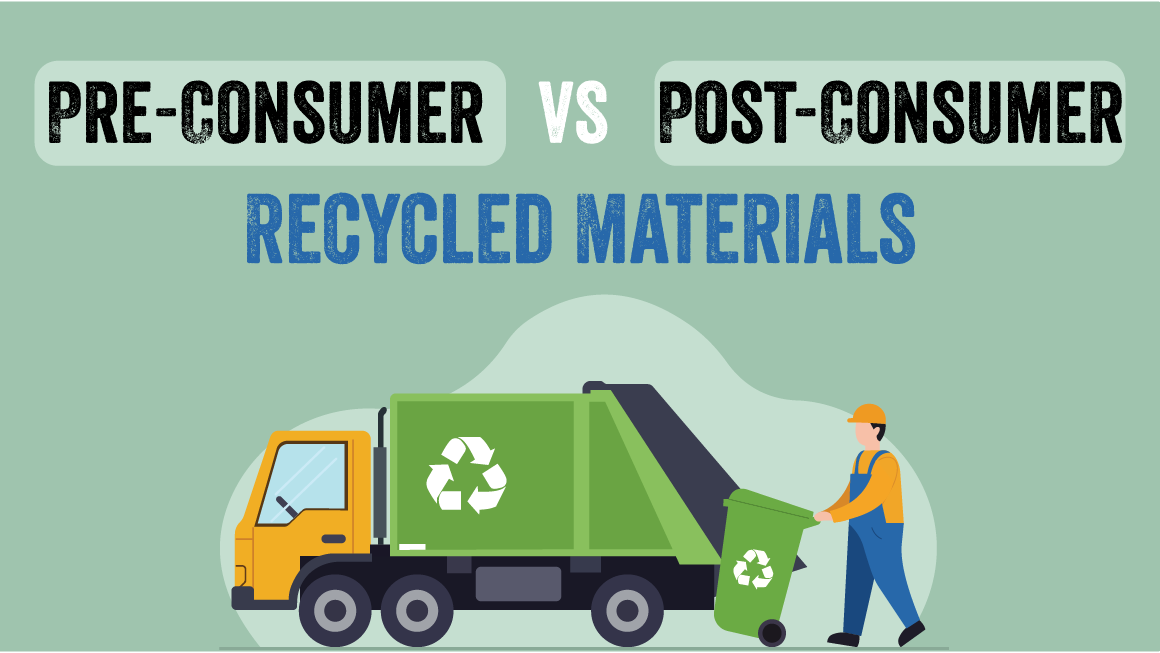Understanding the Difference and Why It Matters
Recycling is a key strategy for reducing resource extraction, lowering carbon emissions, and closing the loop in our materials economy. But looking closer at recycled content, there are two distinct categories that often get lumped together — and understanding the difference matters.
These categories are:
- Pre‑consumer recycled materials
- Post‑consumer recycled materials
This blog will define both, compare their advantages and limitations, and explain how each contributes to more sustainable manufacturing and waste‑management practices.
What is Pre‑Consumer Recycled Material?
“Pre‑consumer” recycled material refers to material that is reclaimed before it ever reaches a consumer. It comes from manufacturing or processing operations rather than from the consumer waste stream.
Examples include:
- Off‑cuts, trimmings, or scrap produced during manufacturing of goods (for example: fabric remnants, sheet‑metal cut‑offs).
- Defective items or rejects that never were sold to a consumer.
Manufacturers often collect these materials in-house, repurpose them, and reintroduce them into the production process. Since the materials never reached the consumer, they don’t carry the same “post‑use” burdens (e.g., contamination from consumer use).
Using pre‑consumer content helps avoid waste from the outset and reduces demand for virgin materials.
What is Post‑Consumer Recycled Material?
By contrast, post‑consumer recycled material originates from items that have reached the end‑use consumer, have served their intended purpose, and then are diverted from the waste stream to be recycled into new products.
Examples include:
- Used aluminum cans, glass bottles, cardboard boxes, plastic containers — after a consumer has used them and recycled them.
- Household, commercial, and industrial items that have reached end‑of‑life and are collected for recycling.
Because the material has served its purpose and recyclers recover it afterward, using post‑consumer content helps divert waste from landfills and supports more circular economy practices.
Key Differences at a Glance
| Feature | Pre‑Consumer | Post‑Consumer |
|---|---|---|
| Origin | Manufacturing/processing waste (never reached consumer) | Consumer or end‑use item diverted from waste stream |
| Contamination & sorting | Often cleaner (controlled manufacturing environment) | More challenging processing (collection, sorting, contamination) |
| Environmental impact | Reduces manufacturing waste and virgin material demand | Also reduces landfill burden and closes the loop in a circular economy |
| Typical uses | Manufacturing feed‑stocks, internal reuse | Consumer‑facing recycled‑content products, branding claims |
| Regulatory recognition | Recognized in standards and definitions, but sometimes given less “circular economy” weight | Often preferred in sustainable procurement for highest impact |
For example, one authoritative FAQ from StopWaste defines:
“Post‑consumer material means a finished material which would normally be disposed of as solid waste having reached its intended end‑use.”
“Pre‑consumer material means material or by‑products generated after manufacture of a product is completed but before the product reaches the end‑use consumer.” StopWaste
And a Canadian regulatory technical paper echoes:
“Pre‑consumer resins are recycled from manufacturing processes prior to their use in a product, while post‑consumer resins are recycled from end‑of‑life products…” Government of Canada
Why Both Matter for Sustainability
It’s not an either/or game — both pre‑ and post‑consumer recycled materials play distinct but complementary roles in sustainability and circular‑economy efforts.
Pre‑consumer benefits include:
- Less waste generated during manufacturing, reducing landfill or energy‐intensive disposal.
- Often more consistent material quality since the stream is controlled.
- Reduced demand for virgin materials.
Post‑consumer benefits include:
- Diverts materials that consumers would otherwise send to landfills or incinerators.
- Helps close the loop (consumer use → recycling → new product).
- Stronger messaging for circular economy and sustainability claims.
However, each has limitations:
- Pre‑consumer may have lower “circular economy” impact because the material never reached the consumer.
- Post‑consumer recycling often faces significant challenges with collection, contamination, sorting, and downstream processing. For instance:
“Post‑consumer material is generally considered more sustainable … because its diversion from landfill is direct.” Okon Recycling+1
In short: the highest impact often comes from increasing post‑consumer recycled content but capturing pre‑consumer waste is also a critical step.
Key Takeaways (TL;DR)
- Pre‑consumer recycled material = manufacturing scraps or off cuts that never reach the consumer.
- Post‑consumer recycled material = items used by consumers, diverted from waste and recycled into new products.
- Pre‑consumer is cleaner and easier to recycle; post‑consumer has greater circular‑economy impact (diverts landfill, closes loop).
- For sustainability and procurement, focus not just on “recycled content” but on the mix of pre‑ vs. post‑consumer.
ADDITIONAL SOURCES:
What’s the Difference Between Pre- And Post-Consumer Recycled Content? (treehugger.com)
Post-Consumer vs. Pre-Consumer Recycling: A Comparison (everydayrecycler.com)
Pre- and post-consumer recycling | Sustainable Yarns



